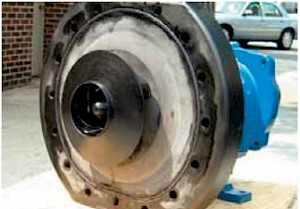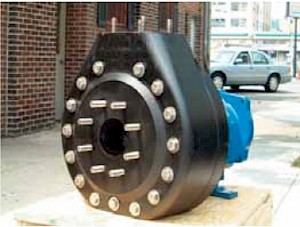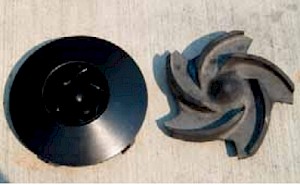
No one would think about buying a car with poor gas mileage or purchasing an ineffi cient refrigerator. However, companies are purchasing pumps with open-faced impellers, which result in a tremendous loss of pump performance and effi ciency. The pump performance and effi ciency of an open-faced impeller continues to decrease as the impeller and the pump casing begin to wear. The performance and effi ciency of an open-faced impeller is a function of the clearance between the impeller face and the suction volute or plate. A fi ve point reduction in performance on a pump that is operating at 50 percent effi ciency will translate into a 10 percent loss of effi ciency and will continue to decrease as the impeller and casing housing wear.

In contrast, the performance of shrouded or enclosed impellers is not dependent on the gap between the impeller and the casing volute. The enclosed impeller’s performance and effi ciency is simply a function of the design of the impeller and casing volute.
Performance tests with the same pump casing volute (Figure 1) show that an identical impeller to the open impeller but with a shroud on the suction side of the impeller increases the effi ciency of the pump by as much as 5.3 percent. It also increases the performance (fl ow) of the pump from 360-gpm to 400-gpm. This test was performed without any modifi cations to the pump and without a casing ring. If a casing ring was installed in the casing volute, the effi ciency and pump performance would have increased even more.
Thousands of pumps operate with open impellers, and some pump designs have even standardized on these openfaced impeller pumps.
Open face impellers are popular because they cost less money to manufacture, so the pump costs less. Unfortunately, these pumps cost more to operate and wear more quickly.
Fortunately, pump users have an option today. End users can replace an open-faced impeller with an enclosed impeller without changing anything else in the pump. Specialty companies can machine a new enclosed impeller from a patented solid block of structural graphite composite, with the result being a strong, lightweight, hydraulically and mechanically balanced, corrosion, erosion and cavitation resistant, and effi cient impeller.
Converting to an enclosed-faced impeller from open-faced eliminates the maintenance headache and guesswork of adjusting open-faced impellers. Since the performance of the open-faced impeller is totally dependant on the gap between the housing and the front of the impeller vanes, it must constantly be adjusted as the impeller and/or housing wears. Finding the new setting is a matter of trial and error. If the impeller is set too close, the impeller vanes will wear prematurely; if the gap is too large, the performance will suffer and the pump will be ineffi cient.
One of the many benefi ts of enclosed structural composite impellers and rings is that the impeller performance will not deteriorate over time like a metallic enclosed impeller or an open-faced impeller. With an enclosed composite impeller, the clearances are permanently set between the impeller wear ring and the pump casing ring or the pump housing. Since the structural composite will not gall, seize or corrode like metallic rings, the clearances can be controlled, as can the pump performance and effi ciency. Figure 2 shows that an enclosed structural composite impeller will increase the head-capacity (H-Q) curve after 1,000 hours of operation as a result of the rings and impeller operating together.

A 4 x 3 – 9 chemical pump with an enclosed impeller instead of an open impeller.

The same 4 x 3 – 9 chemical pump was originally designed with an open impeller.

The chemical pump (for use with HCL acid) was performance tested with the open impeller and then again with an enclosed impeller. The results show a substantial improvement in effi ciency and an increase in the headcapacity (H-Q) curve. The enclosed impeller would then be trimmed to the original performance specifi cations.

This picture shows a comparison of two impellers—one open-faced and one enclosed. This openfaced impeller (right) was redesigned and converted into an enclosed impeller (left). The result was a substantial increase in the pump performance, effi ciency and reliability.


